Related Research Articles

Animation is a filmmaking technique by which still images are manipulated to create moving images. In traditional animation, images are drawn or painted by hand on transparent celluloid sheets (cels) to be photographed and exhibited on film. Animation has been recognized as an artistic medium, specifically within the entertainment industry. Many animations are computer animations made with computer-generated imagery (CGI). Stop motion animation, in particular claymation, has continued to exist alongside these other forms.
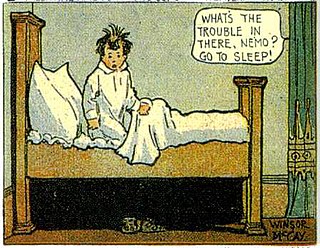
Little Nemo is a fictional character created by American cartoonist Winsor McCay. He originated in an early comic strip by McCay, Dream of the Rarebit Fiend, before receiving his own spin-off series, Little Nemo in Slumberland. The full-page weekly strip depicted Nemo having fantastic dreams that were interrupted by his awakening in the final panel. The strip is considered McCay's masterpiece for its experiments with the form of the comics page, its use of color and perspective, its timing and pacing, the size and shape of its panels, and its architectural and other details.
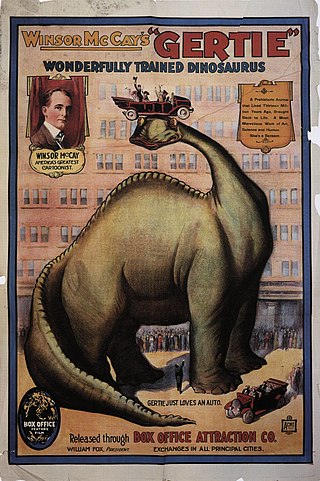
Gertie the Dinosaur is a 1914 animated short film by American cartoonist and animator Winsor McCay. It is the earliest animated film to feature a dinosaur. McCay first used the film before live audiences as an interactive part of his vaudeville act; the frisky, childlike Gertie did tricks at the command of her master. McCay's employer William Randolph Hearst curtailed McCay's vaudeville activities, so McCay added a live-action introductory sequence to the film for its theatrical release renamed Winsor McCay, the Famous Cartoonist, and Gertie. McCay abandoned a sequel, Gertie on Tour, after producing about a minute of footage.

Limited animation is a process in the overall technique of traditional animation that reuses frames of character animation.

Zenas Winsor McCay was an American cartoonist and animator. He is best known for the comic strip Little Nemo and the animated film Gertie the Dinosaur (1914). For contractual reasons, he worked under the pen name Silas on the comic strip Dream of the Rarebit Fiend.

Dream of the Rarebit Fiend is a newspaper comic strip by American cartoonist Winsor McCay, begun September 10, 1904. It was McCay's second successful strip, after Little Sammy Sneeze secured him a position on the cartoon staff of the New York Herald. Rarebit Fiend appeared in the Evening Telegram, a newspaper published by the Herald. For contractual reasons, McCay signed the strip with the pen name "Silas".

One Hundred and One Dalmatians is a 1961 American animated adventure comedy film produced by Walt Disney Productions with distribution by Buena Vista Distribution. Adapted from Dodie Smith's 1956 novel of the same name, the film was directed by Hamilton Luske, Clyde Geronimi, and Wolfgang Reitherman from a script by Bill Peet. It features the voice talents of Rod Taylor, J. Pat O'Malley, Betty Lou Gerson, Martha Wentworth, Ben Wright, Cate Bauer, Dave Frankham, and Fred Worlock.
The silent age of American animation dates back to at least 1906 when Vitagraph released Humorous Phases of Funny Faces. Although early animations were rudimentary, they rapidly became more sophisticated with such classics as Gertie the Dinosaur in 1914, Felix the Cat, Oswald the Lucky Rabbit, and Koko the Clown.

Marc Fraser Davis was a prominent American artist and animator for Walt Disney Animation Studios. He was one of Disney's Nine Old Men, the famed core animators of Disney animated films, and was revered for his knowledge and understanding of visual aesthetics. After his work on One Hundred and One Dalmatians he moved to Walt Disney Imagineering to work on rides for Disneyland and Walt Disney World before retiring in 1978.
John Cannizzaro Jr., better known as John Canemaker, is an American independent animator, animation historian, author, teacher and lecturer. In 1980, he began teaching and developing the animation program at New York University, Tisch School of the Arts', Kanbar Institute of Film and Television Department. Since 1988 he has directed the program and is currently a tenured full professor. From 2001-2002 he was Acting Chair of the NYU Undergraduate Film and Television Department. In 2006, his film The Moon and the Son: An Imagined Conversation, a 28-minute animated piece about Canemaker's relationship with his father, won the Academy Award for best animated short. In 2007 the same piece picked up an Emmy award for its graphic and artistic design.

Wolfgang Reitherman, also known and sometimes credited as Woolie Reitherman, was a German–American animator, director and producer and one of the "Nine Old Men" of core animators at Walt Disney Productions. He emerged as a key figure at Disney during the 1960s and 1970s, a transitionary period which saw the death of Walt Disney in 1966, with him serving as director and/or producer on eight consecutive Disney animated feature films from One Hundred and One Dalmatians through The Fox and the Hound.

The Sinking of the Lusitania (1918) is an American silent animated short film by cartoonist Winsor McCay. It is a work of propaganda re-creating the never-photographed 1915 sinking of the British liner RMS Lusitania. At twelve minutes, it has been called the longest work of animation at the time of its release. The film is the earliest surviving animated documentary and serious, dramatic work of animation. The National Film Registry selected it for preservation in 2017.

Kenneth B. "Ken" Anderson was an American animator, art director, layout artist, and storyboard artist at Walt Disney Animation Studios for 44 years. He had been named by Walt Disney as his "jack of all trades".
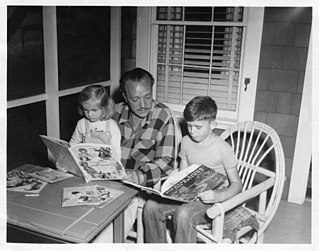
Gustaf Adolf Tenggren was a Swedish-American illustrator and animator. He is known for his Arthur Rackham-influenced fairy-tale style and use of silhouetted figures with caricatured faces. Tenggren was a chief illustrator for The Walt Disney Company in the late 1930s, in what has been called the Golden Age of American animation, when animated feature films such as Snow White and the Seven Dwarfs, Fantasia, Bambi and Pinocchio were produced.

How a Mosquito Operates is a 1912 silent animated film by American cartoonist Winsor McCay. The six-minute short depicts a giant mosquito tormenting a sleeping man. The film is one of the earliest works of animation, and its technical quality is considered far ahead of its time. It is also known under the titles The Story of a Mosquito and Winsor McCay and his Jersey Skeeters.

A chalk talk is an illustrated performance in which the speaker draws pictures to emphasize lecture points and create a memorable and entertaining experience for listeners. Chalk talks differ from other types of illustrated talks in their use of real-time illustration rather than static images. They achieved great popularity during the late nineteenth and early twentieth centuries, appearing in vaudeville shows, Chautauqua assemblies, religious rallies, and smaller venues. Since their inception, chalk talks have been both a popular form of entertainment and a pedagogical tool.

Disney's Nine Old Men were a group of Walt Disney Productions' core animators, who worked at the studio from the 1920s to the 1980s. Some of the Nine Old Men also worked as directors, creating some of Disney's most popular animated movies from Snow White and the Seven Dwarfs to The Rescuers. The group was named by Walt Disney himself, and they worked in both short and feature films. Disney delegated more and more tasks to them in the animation department in the 1950s when their interests expanded, and diversified their scope. Eric Larson was the last to retire from Disney, after his role as animation consultant on The Great Mouse Detective in 1986. All nine members of the group were acknowledged as Disney Legends in 1989 and all would receive the Winsor McCay Award for their lifetime or career contributions to the art of animation.
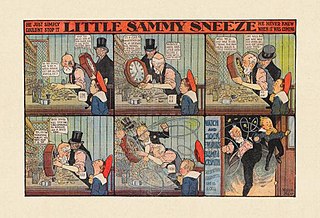
Little Sammy Sneeze was a comic strip by American cartoonist Winsor McCay. In each episode the titular Sammy sneezed himself into an awkward or disastrous predicament. The strip ran from July 24, 1904 until December 9, 1906 in the New York Herald, where McCay was on the staff. It was McCay's first successful comic strip; he followed it with Dream of the Rarebit Fiend later in 1904, and his best-known strip Little Nemo in Slumberland in 1905.
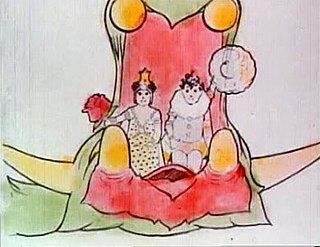
Winsor McCay: The Famous Cartoonist of the N.Y. Herald and His Moving Comics, more commonly known as Little Nemo, is a 1911 silent animated short film by American cartoonist Winsor McCay. One of the earliest animated films, it was McCay's first, and featured characters from McCay's comic strip Little Nemo in Slumberland. Its expressive character animation distinguished the film from the experiments of earlier animators.

Barrier-grid animation or picket-fence animation is an animation effect created by moving a striped transparent overlay across an interlaced image. The barrier-grid technique originated in the late 1890s, overlapping with the development of parallax stereography (Relièphographie) for 3D autostereograms. The technique has also been used for color-changing pictures, but to a much lesser extent.
References
- ↑ Hopwood, Henry V. (August 21, 1899). "Living pictures; their history, photoproduction and practical working. With a digest of British patents and annotated bibliography". London Optician & Photographic Trades Review – via Internet Archive.
- ↑ Berthier, Auguste (May 16 and 23, 1896). "Images stéréoscopiques de grand format" (in French). Cosmos34 (590, 591): 205–210, 227-233 (see 229–231)
- ↑ Timby, Kim (May 1, 2001). "Images en relief et images changeantes. La photographie à réseau ligné". Études photographiques (9): 124–143 – via journals.openedition.org.
- ↑ Sharp, Jasper (September 23, 2004). "Pioneers of Japanese Animation (Part 1)". Midnight Eye. Retrieved 12 December 2009.
- ↑ Official booklet, The Roots of Japanese Anime, DVD, Zakka Films, 2009.
- ↑ Scheerhout, John (12 September 2002), "Honour for 'Dalmatians' Dodie", Manchester Evening News , retrieved 14 January 2010
- ↑ Smith, Dodie (2018). The Hundred and One Dalmatians & The Starlight Barking – Modern Classics. About The Author: Egmont UK Ltd. ISBN 978-1405288750.
- ↑ "10 Things You Didn't Know About 101 Dalmatians". Oh My Disney. "2. The story is based on Dodie Smith's own experience". c. 2015. Retrieved 7 December 2019.
{{cite web}}: CS1 maint: location (link) - ↑ "One Hundred and One Dalmatians (1961)". AFI Catalog of Feature Films . American Film Institute. Archived from the original on January 2, 2024. Retrieved January 2, 2024.
- ↑ Bendazzi, G. (2015). Animation: A world history. Volume I: Foundations - the golden age. London: Focal Press. pp. 240–256. doi:10.4324/9781315721057. ISBN 9781317520832 . Retrieved 2 February 2016.
- ↑ Klatt, O. "Animated Success: The Life of Germany's Own Walt Disney". spiegel.de. Retrieved 28 January 2016.
- ↑ Moritz, W. "The Case of Hans Fischerkoesen". www.awn.com. Retrieved 6 January 2016.
- ↑ Canemaker, John (2005). Winsor McCay: His Life and Art . Harry N. Abrams, Inc. ISBN 0-8109-5941-0.page #?
- ↑ Bob McCay at the Lambiek Comiclopedia
- ↑ McCay, Bob at Bails, Jerry, and Hames Ware, Who's Who in American Comic Books 1929–1999
- ↑ Brook, Marisa. "Drawing the Shorter Straw". Damn Interesting. Retrieved 19 September 2018.
- ↑ Giannalberto Bendazzi (Anna Taraboletti-Segre, translator); Cartoons: One Hundred Years of Cinema Animation; Indiana University Press; ISBN 0-253-20937-4 (paperback reprint, 2001)
- ↑ "GUSTAF A. TENGGREN, CHILDREN'S ARTIST". The New York Times. 9 April 1970. Retrieved 2018-11-05.
- ↑ Conrad, JoAnn. Fantasy Imaginaries and Landscapes of Desire: Gustaf Tenggren’s Forgotten Decades
- ↑ John Canemaker, Before the animation begins : the art and lives of Disney inspirational sketch artists, New York : Hyperion, 1996 ISBN 978-0-7868-6152-1